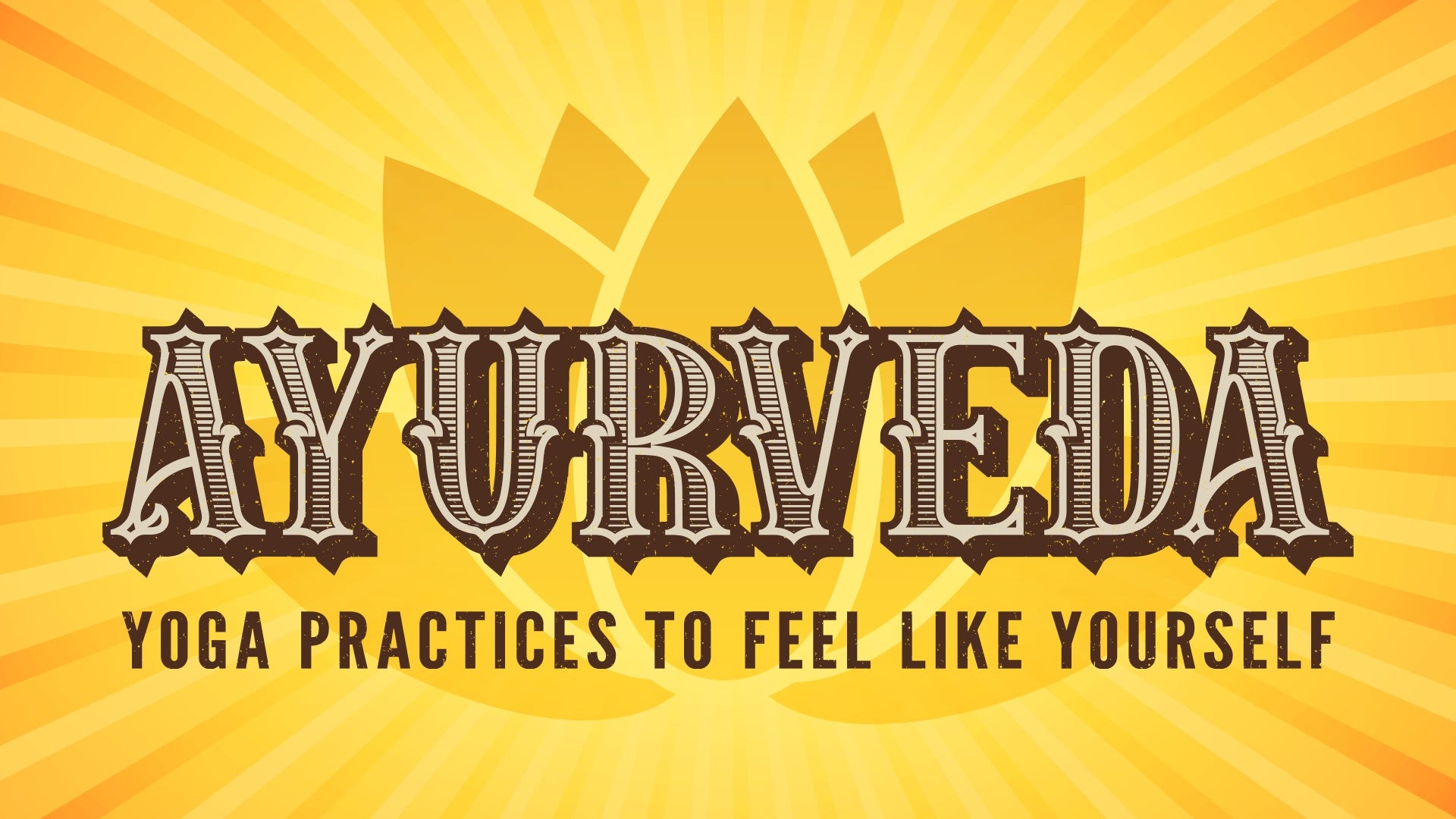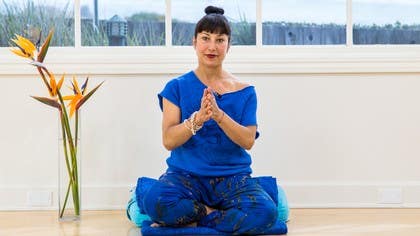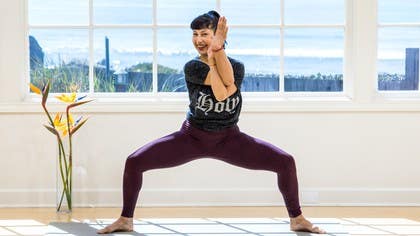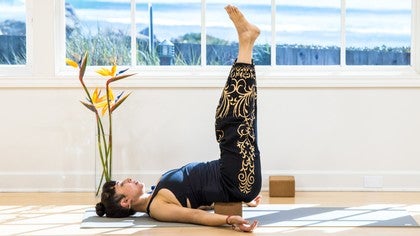Description
About This Video
Transcript
Read Full Transcript
Namaste. I'm Ali and I'm here today to talk to you about one of my favorite subjects, Ayurveda. What is Ayurveda? Well, ayu means life and veda means science or knowledge of. So Ayurveda is literally the science of life. It's a system that addresses each of us holistically. It addresses our physical needs. It addresses our mental and emotional needs. And it even addresses our spiritual needs. It's a system that recognizes each of us as an individual. And it also gives us general guidelines that can be used universally. It's a system that doesn't promise a quick fix, but does promise that even the smallest changes that we make guide us gently towards perfect health and balance.
Let's start off with a word you might have heard before, and that word is dosha. So everything that is manifest has a dosha. The floor that I'm sitting on has a dosha. The clothing that I'm wearing has a dosha. We have a dosha. The weather outside has a dosha. And one thing that we do know about dosha is that it changes. The weather outside changes and we change. And so our needs are going to change from season to season, day to day, even minute to minute.
There are three different dosha's, and each one is associated with a pair of what's called the five great elements, or the pancha maha bhutas. Those elements are earth, water, fire, air, and space. Kapa dosha is associated with earth and water. Pitta dosha is associated with water and fire. And vata dosha is associated with air and space. So what does the dosha look like in us, and how does it affect the way that we think, the way that we feel?
Well, all of the dosha's have good points and not so good points, and today I'm going to start with the good stuff. So let's start off with kapha dosha physically. Well, we know the kapha dosha is associated with earth and water. So a kapha body, what that looks like physically in balance, is going to be very strong and very sturdy. There'll be stability to their bodies. That's that earth element.
And there's also that watery sensuality to their body, so there might be a beautiful curve into their bodies. The shape to look for with kapha dosha physically is going to be round. Earth is round, so the eyes could be very round. There could be a roundness to the body. And if we even think about the colors of earth and water, those will show up in kapha dosha as well. So generally the eyes are a dark brown, a dark rich brown.
They could also be a very clear green. Usually the hair is dark. It's not a rule, but usually the hair is dark. But a quality to look for with kapha dosha, something that you can look for right away, is the skin. Kapha skin is going to be smooth and soft and beautiful, like baby skin. Kapha people, when they are in balance, are very vibrant and healthy and strong looking.
And that's the physical aspect of it. In terms of the mental and emotional aspect, if we think of somebody as being very earthy, what springs into your mind? Kapha people generally are very loyal, they're very friendly, very grounded, and very nurturing. They have a tendency to do things very slowly, so they might learn slowly, but they'll never forget. So your kapha friend is the one who's going to remember your birthday, is going to remember your anniversary, is going to remember the name of your dog, the name of each of your children, the fact that you like green apples and not red ones.
That's a very kapha thing because they're very thoughtful, loving people. They want to take care of you. So they might be drawn into situations where they are literally taking care of people. If you're somebody who is always the one that your friend calls when they're upset, that might be some kapha in you. If you're the one whose house everyone likes to go to for dinner, that could also be some kapha in you.
And that's kapha dosha. So now let's move on to pitta. Pitta, as we remember, is associated with the qualities of water and fire. So if you think about it, if you already have a lot of heat, chances are good that you don't do as well in the sun. If you don't do as well in the sun, it might be because your skin is a little bit lighter.
It could also have some of the sun colors in it already. It might have a reddish or a yellowish undertone. So if the skin is a little bit lighter, the hair is a little bit lighter. The eyes are a little bit lighter. And a lot of times with pitta, they have very fiery eyes, very captivating eyes.
Mentally and emotionally, pitta people have that fire. So yes, they love a challenge. They also are great leaders. They're great speakers. They have a lot of charisma.
You're definitely going to know when they come into the room because they're probably going to be the life of the party. And that's your pitta dosha in balance. And let's move on into vata people. So vata, as we remember, is associated with the elements of air and space. And a vata body will reflect that.
There'll be a lightness to it. There'll be more slender generally. And their movements will be quick but very graceful when they're in balance. Because vata is associated with the quality of coldness, they need more sun. They need more warmth.
So their skin is probably going to be a bit darker. And with that darker skin will come darker hair and darker eyes. And because they are associated with the element of space, they might look sort of unusual. They'll have an unusual or exotic beauty to them. Mentally and emotionally, they're very connected to air and space, which means they could be super creative, very spiritual, curious, imaginative, even a little dreamy.
Definitely very adventurous. And the kind of person who really forges their own way. They don't need to follow the pack or follow the group. They don't want to necessarily be the leader. They're kind of off on the side doing their own thing.
And that is a vata in balance. So all of the dosha's have their great qualities and they're not so great qualities. I'm going to address a few of the common imbalances that we see with each of the dosha's. So with kapha dosha, physically out of balance, it's going to be anything where we feel heavy, where we feel slow or stuck. So what would that look like?
Well, kapha people love to sleep and they love to eat and they can get a little overweight. Another big issue can be anything where there's too much liquid because they've got that water element. So it could be runny noses, wet coughs. Even the skin can get congested and blocked. So there might be issues with oily skin, oily hair.
And because there is that quality of slowness, that could manifest in hypothyroidism. Kapha out of balance mentally and emotionally will also be any situation where we feel a little stuck or a little heavy. And that could look like the kind of depression where we can't get out of bed, where all we want to do is sleep all day. That could look like any situation where we're stuck, we don't feel happy, but we can't really make ourselves change. And that's usually the issue that comes up with kapha mentally or emotionally.
Let's move on to pitta. Pitta, physically out of balance, will be any condition that is associated with having too much heat in the body. That could look like acid reflux, acid indigestion. It could be diarrhea. It could be a situation where the skin gets too hot or inflamed.
Inflammatory conditions in the body in general are associated with excess pitta. On the mental and emotional side, again, that feeling of having too much heat. So it might be frustration. It could be anger, feeling a bit judgmental or bossy. The times where we feel like we get a little loud or aggressive, that would be excess fire or excess pitta.
Moving on to vata, out of balance. I mentioned that vata can be very slender. Out of balance, that can go too far. So vata people can get too thin, even a little bit emaciated. Conditions that come out of that, like being anemic or low bone density, brittle bones, having trouble with fertility or not having a regular cycle for women.
Mentally and emotionally, that quality of space, spaciness. So vata, out of balance, could be forgetful or spacey, scattered. And because their minds are so quick, they might project things into the future beyond what they need to. And that could look like anxiousness, anxiety, worry, even fear. We know that each of the doshas has their great qualities.
And now we know something about some of the bad qualities. The question becomes, what do I do? How do I go from feeling out of balance to feeling healthy, to feeling good, to feeling balanced? Happily, there are some really easy, accessible, quick tools that we can use to feel better. With kapha dosha, we know that there's that heaviness, that stuckness.
So the remedy is going to be to do the opposite, because that's one of the main things to remember with Ayurveda. Like increases like. Opposite balances us out. So if we're feeling heavy, if we're feeling slow, we need to do things that make us feel light and fast. And that means get moving. And we know it's difficult.
You know, there's times where we do want to spend the day in bed. The hardest thing to do is to get out of bed and go to that yoga practice. And yet it's the best thing for us. So if we're feeling a little slow, sluggish, excess kapha, get moving. Do something that is heating, something that is detoxifying.
Do something that gets us out of our normal routine. That class that you've always wanted to try, that person that you've always wanted to call, that place that you've always wanted to go. Do something different, something out of the routine that gets us unstuck. In our yoga practice, that could look like an inversion that we've never tried before that has been a little scary for us. It might look like heating the practice up with some core work or some twisting, maybe even moving a little bit faster than we normally do.
Less time in shavasana, less time in restoratives. Heat things up a little bit, crank up the heat, don't be afraid to get a good sweat going. For pitta, some quick fixes to get us back in balance. Well, we know that pitta is very hot, so anything that feels cooling and calming and fun. Pitta people, turn off the phone, turn off the computer, turn off the TV set.
Stop listening to the news. Go dancing. Go do something that is not related to work at all. Go have some fun. Another important thing to keep in mind is to stay cool.
So maybe go into a room that is a little darker and cooler, grab a washcloth, soak it in some cold water, put it over your eyes, lay back and chill out. What would that look like in our yoga practice? Let's start off with the cooling quality. Some hip openers and some forward bends are a great idea. Because pitta can be a little bit self-centered, try some partner yoga or invite a few friends over to join you when you practice.
And there's one other thing with pitta, because pitta minds are so sharp and because they love a challenge and they love to figure things out, let's use the best of that. That one pose that you've always wanted to do but never quite managed to, this would be a good time to work on it. Put that pitta mind to use. Give it a good challenge and then cool it down and let it go. And that's not going to be easy either because with pitta people, we don't like to let things go.
We want to get it. So let's see if we can be okay with just letting it go. Vata people. We remember that vata is cold and light and dry, so we want to do things that feel warm, heavier and oilier. And what does that mean?
I always say with vata, think of yourself as a baby. How would you treat a baby? You would make sure that the baby stayed warm. You would make sure that the baby ate food that was easy to digest and sweet. You would make sure that the baby was wrapped up and protected and taken care of.
So something like a warm bath would be a great idea. Listen to some soft, beautiful music. In your yoga practice, move a little bit slower. Move a little bit smoother. Give yourself more time to hang out in certain poses, especially ones that are low to the ground, that are very opening.
And some stuff that builds a little bit of heat and a little bit of strength, but an important thing to remember with vata is that vata can go out of balance incredibly easy. Vata is incredibly sensitive, so not too much of anything. And that means slow down, do one thing at a time. If there's one thing I can tell you about to people, stop reading so many books at the same time. One book at a time.
One thing at a time. One idea at a time. Finish what we started. We've made some segments for you that will balance out each of the dosas. Segments for the morning and segments for the evening.
Segments that will use the best of each dosa and balance out the things that are not so great. We've also made some shorter segments for you that will give you five minute routines that you can do in the moment just to instantly feel a little bit more balanced. So I'm going to close this out with a few important things to remember. Number one, like increases like. Similar to the system of yin and yang or hot da yoga.
If we know that we're feeling very hot, do something to cool it down a little bit. If we know that we're feeling very dry, we want to do something that produces more liquid. If we know we're feeling heavy, we'll do something that lightens us up. And if we know we're feeling too light, we'll do something that is very grounding. And once we have that understanding, it's actually incredibly empowering.
Because we can see, okay, this is where I got out of balance. This is where I did too much. And so I can do the opposite and come back into the center. The second thing to remember is that Ayurveda is not a quick fix because it treats the source of things and not just the symptom. And yet within that, even the smallest change, the littlest shift can make such a difference.
I encourage you to think of this as a slow, steady journey towards complete balance and total health. Because once we have the information, then the responsibility lies with us. We know what makes us feel good, and we know what makes us feel not so good. If we know that we want to feel healthy and vibrant and able to do the work that we're meant to do in this world, then we stay with the practices that make us feel good. I'm so grateful to these incredible ancient teachings that give us so many tools to stay in balance, even in our modern and contemporary life.
So I invite you to learn more, to study, to empower yourself with this wisdom. And I can't wait to see where it leads all of us. Thank you so much for joining me today. Namaste.
Ayurveda: Practices to Feel Like Yourself
Comments
michelle
loveandpeacexxxx
You need to be a subscriber to post a comment.
Please Log In or Create an Account to start your free trial.


















